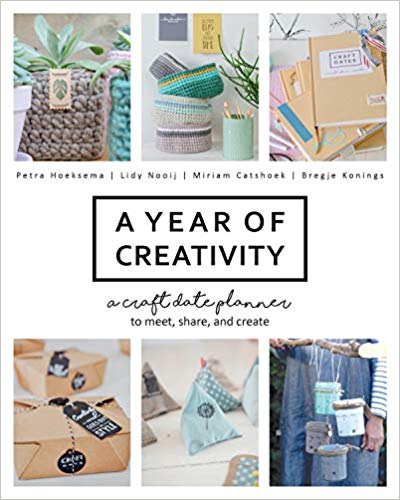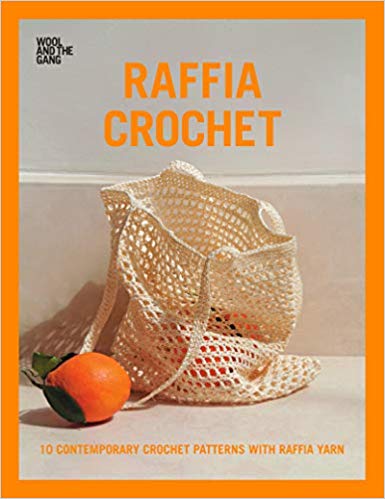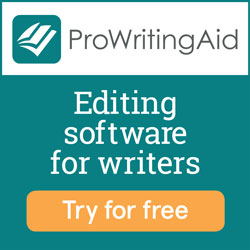Reading Fanatic Reviews
CraftsA Year of Creativity by Petra Koeksema et al.

A Year of Productivity*
Craft Date Ideas
The subtitle of this book states that it is a “craft date planner.” I believe the authors misspoke. When I think of a planner, I think of something that I can write in as I strategize something, whether it’s my day or a project. This is really more of a book that introduces the concept of a craft date if you aren’t familiar with it and gives some ideas for projects for the group.
The idea of a craft date is to get together with like-minded friends and craft together. Sometimes, the group might work on a single project together, like a gift for a mutual friend. Other times, the group might work individually, each participant making the same project but fashioned for her own likes and dislikes. Another possibility would be to work on a variety of small projects during the craft date time. As you can see, it really depends on what the group wants to do in general and on a particular day.
The bulk of the book is pictures of and directions for a variety of projects that a craft date group could do. In the table of contents, these are color coded to show whether they are short, longer, or cooperative projects. In flipping through the book, none of them looked particularly difficult, which I imagine would be a criterion for a craft date project. The crafts in this book include crochet, knitting, sewing, and even a little straight-up crafting, like making a wooden coat rack or a tool station. Each project has packaging instructions—some very creative—if you are planning to give the item as a gift.
When looking at the projects themselves, some were wholly contained within the main portion of the book, while others had directions (partial or complete) in the back of the book. I know this is a long-standing tradition in craft books, but I’m not a particular fan of it, and I don’t think it was well done in this book. It made for a very picture-heavy central portion and a very text-heavy end section. There was one project where all it showed were pictures in the main part—four pages worth—and had the directions only in the back. I would have loved to have seen all the directions integrated into the main part with the photographs scattered throughout the project’s section. It just breaks up the tedium of the pages and helps you to see what a project should look like, from a variety of angles, when the directions and the picture are on the same page.
I am a knitter and crocheter, but I do not sew nor do I do the other types of crafts that are in this book. In looking at the directions for the knitting and crochet projects, I found them to be straightforward and easy to read. I also like the diagrams for crochet. I thought that the way the patterns were written was a little odd. Having crafted since I was a teenager, I am very familiar with pattern shorthand (i.e., dc for double crochet or K5 to mean “knit 5 stitches”). This book didn’t use that, and it actually felt strange to see all those words written out. Perhaps if the authors had used the standard shorthand, they could have included the full directions in the main part of the book like I mentioned before.
The book definitely has some projects that look like they are worth doing, either alone or in a group. As someone who has crafted off and on throughout her life, this is just the sort of book to fire up my imagination and make me want to break out my favorite crafting tools and have a go. They would be more fun to do with others, that’s for sure, especially if the group is made up of truly like-minded individuals.
A Map for Wild Hearts by Andrea Hannah
Available at Amazon and Barnes & Noble
A Map for Wild Hearts*
An Odd but Lovely Journey into the Heart of Creativity
This will probably sound weird, but I chose this book at my favorite book review site because I was perplexed by its description. I couldn’t really tell what the book was about from the blurb or the title and subtitle, so I was curious about what the book actually contained. In this book, the author leads you through making a physical map that expresses aspects of you and your creative bent. In the first part of the book, she goes over the obstacles to creativity. Once those shackles are off, she hopes to lead you on a creative journey of self-discovery that will help you in your future creative endeavors. It is a little hard to explain because the whole book is very right brained; the logical part of my mind is having a hard time pulling together all that this book is and what it intends to do. The author shares many personal stories throughout the entire book and provides a blueprint for making an actual physical map of what creativity means to you. Each main chapter has exercises to get you thinking about various aspects of yourself and the creative process. Even if you don’t want to make a physical map like the book lines out, some ideas she has you think about are worthwhile for anyone who engages in a creative endeavor.
The author doesn’t want to limit the types of creativity that her maps can be applied to, whether you see yourself as a creative making art (visual, literary, etc.), or whether you are just someone who likes to live life creatively (like someone who delights in their beautiful garden). If you see yourself as someone who is creative and would like to play creatively with your creativity :-), you might enjoy this somewhat strange but intriguing book.
Celestial Watercolor by Elise Mahan
Available at Amazon, Barnes & Noble, iBooks, Kobo, Google Play, Thalia, Mondadori, Angus & Robertson, Indigo (Chapters), and Bol.de
Celestial Watercolor*
Beautifully Illustrated, But a Little Light on Instruction
In this beautifully illustrated book, the author gives tips and insights on how to make watercolors of the constellations of the signs of the zodiac, the moons of the year, and the seasonal night sky. While she does have a brief section going over tools and techniques and more detailed information about how to each different celestial painting type, you will most likely need to be already well-versed in watercolor before attempting what she suggests. The sections on the signs of the zodiac and types of moons themselves not only show her lovely paintings of each sign, but you also get brief lessons about astrology and the moons! If watercolor interests you, or if you want to paint the night sky, or if you love astrology, you will most likely find inspiration in this charming art book.
Raffia Crochet by Wool and The Gang

Only available in paperback
Amazon, Barnes & Noble
Raffia Crochet*
Ten Basic Crochet Projects Using Raffia
In this book, designers for Wool and the Gang have gathered ten patterns that use their yarn Ra-ra-raffia. Most of the designs are for accessories and things for around the house, like a placemat, backpack, or shopping bag. The first pattern is for a hat that actually does look like it would be perfect for summer. I’ve been a crocheter and a knitter for a long time, but I had never heard of raffia being used like yarn to make projects. Other than the plant hanger, I actually liked the projects in this book; they seem very functional (although I wish the placemat was rectangular and not round). I could see how for specific items, especially the bags, raffia could be a good material from which to make them. The patterns are mostly simple and straightforward. For a few of them, there are instructions given how to jazz them up a little with some applique. If you’ve done much crocheting, there’s little here that’s beyond your reach. There is a section in the back that does give some description of technique, like how to do a magic loop. The book is limited with only ten projects. I also felt that there was some inconsistency in how the patterns were written. But if you are interested in some basic raffia crochet projects, you might enjoy this book.
Step-By-Step Guide to 200 Crochet Stitches by Tracey Todhunter
Available in paperback only
Available at Amazon, Barnes & Noble, Interweave, Target
Step-by-Step Guide to 200 Crochet Stitches*
Beautiful, Clear Collection of Stitches
If you enjoy crocheting, this book would be a good one to add to your crafting books. It is chock full of 200 basic and not-so-basic crochet stitches, including some intriguing ones like Embossed Shells, Four-Leaf Clover, Popcorn Mesh, Granny Spike Stitch, Post Stitch Stripes, Little Arcs, Textured Wave, Tunisian Honeycomb, and Crown Picot Edging.
I’ve been crocheting for over 30 years, and I saw some old friends and some new ones that make me want to dig out my hooks and yarn and start playing around with these stitches! I can think of no better recommendation of a book than that.
You definitely need to have a good sense of basic crochet, like how to do a chain, single crochet, double crochets, post stitches, etc. The Basic Stitches section at the front of the book does not contain these simplest of stitches; rather those stitches are more along the lines of slightly altered basic stitches like the Purl Slip Stitch and Shallow Single Crochet. There is a section called Crochet Skills in the back which does show some crochet basics, but many of the stitches in the main part of the book are complex enough that you’d want to have some solid experience under your belt before you attempt them. You don’t need a lot of experience, just enough to feel comfortable working with crochet projects.
The stitch sections in the main part of the book include Basic Stitches; Fans & Shells; Clusters, Puffs, & Popcorns; Spike Stitches; Raised Stitches; Mesh and Filet; Lace & Openwork; Waves & Chevrons; Textured Stitches, Tunisian Stitches; Colorwork; and Edgings. Each stitch has a full-color photo of multiple rows as well as up-close pictures of the yarn and hook every one or two steps. There is also a stitch diagram if you prefer working with those. If you are a visual learner, it’s nice to see exactly what you’re supposed to do or what the result is.
My only complaint is that some of the yarn and hook combinations don’t show enough contrast between the yarn and hook colors. For instance, there’s a whole set of stitches that use a golden yarn with what looks like a light wooden hook. These two colors blend together too easily and you don’t see the contrast.
Again, if you love to crochet, I would suggest picking this book up, digging out your hooks, busting into your stash, and start having fun!






